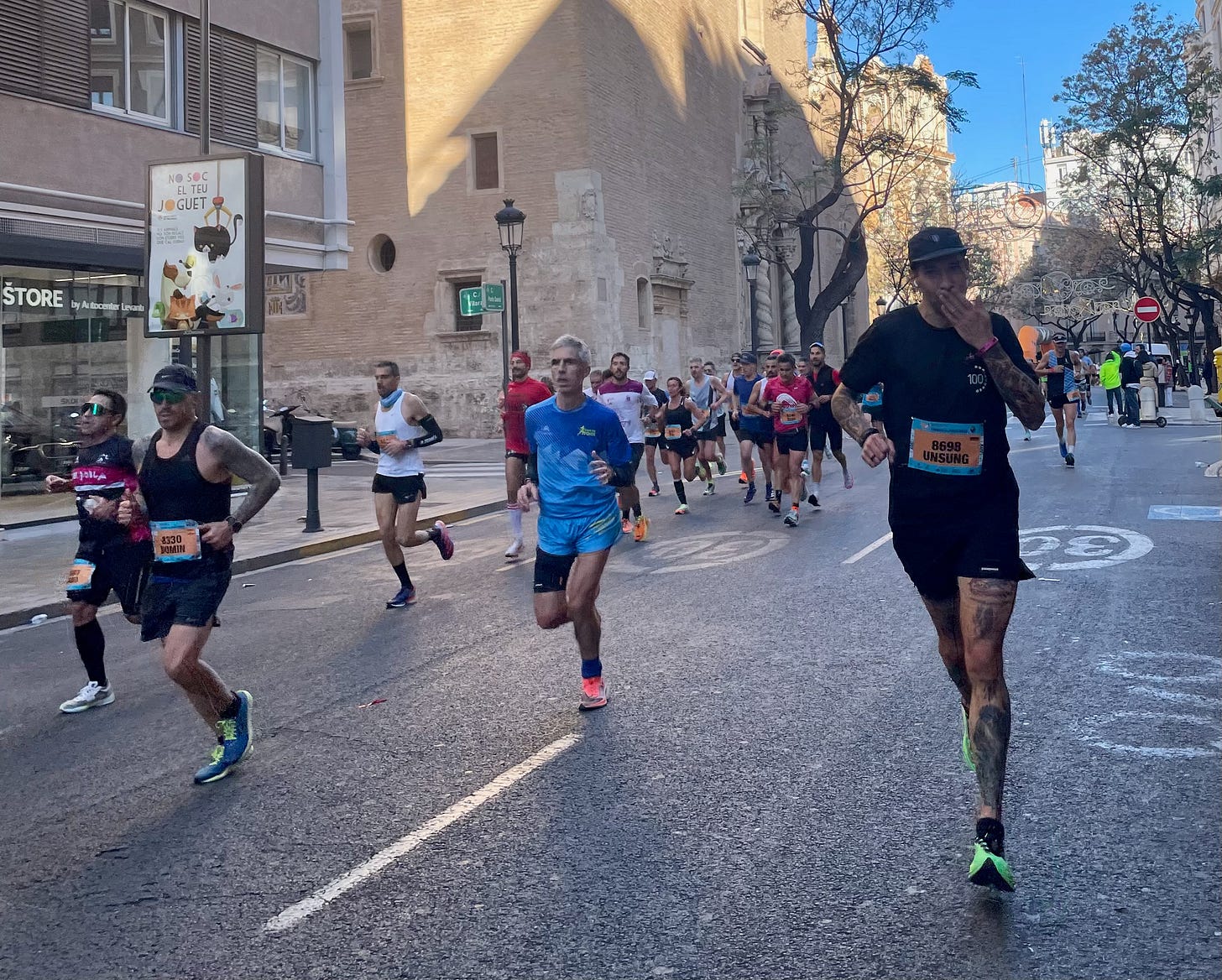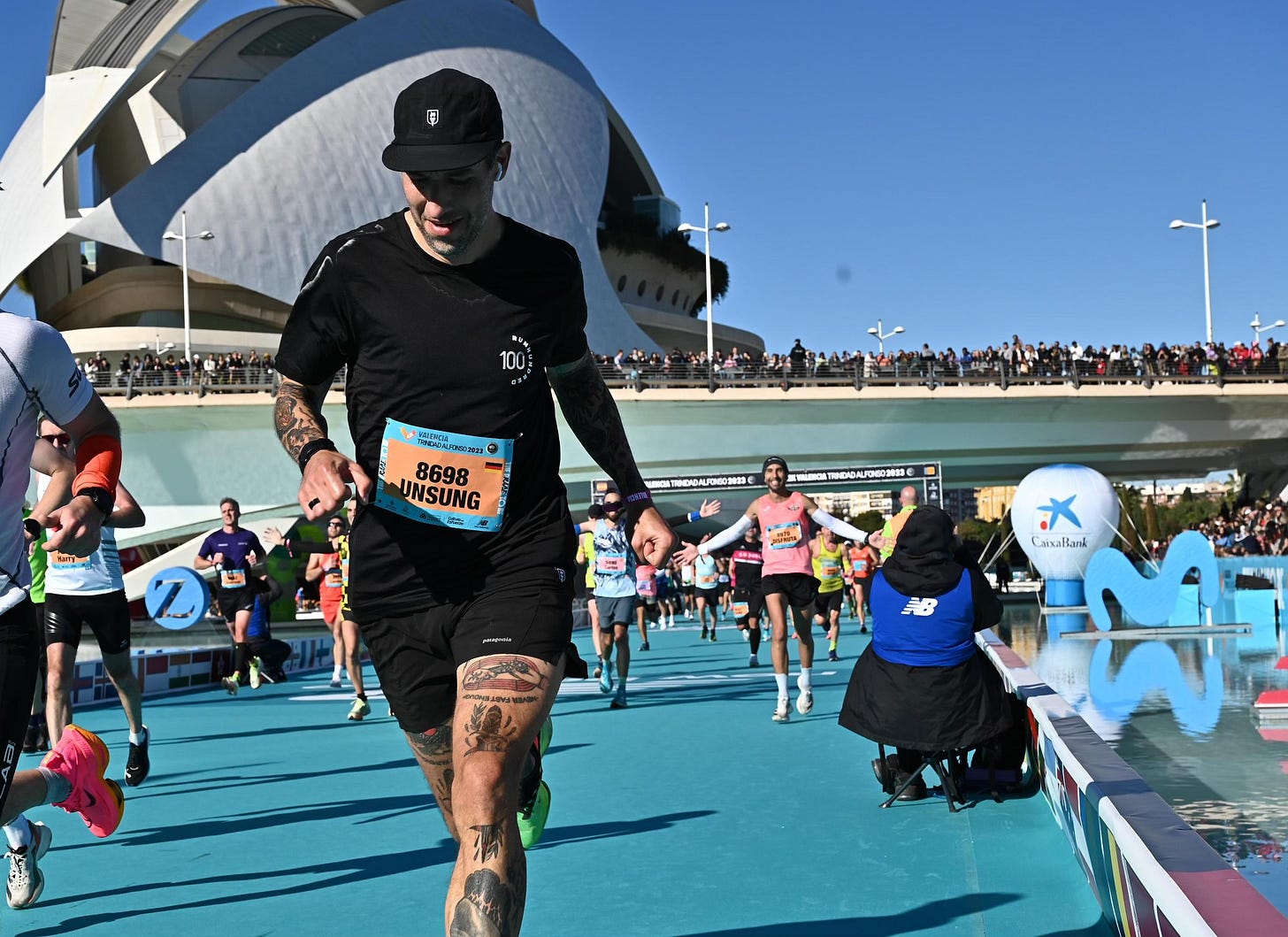I talked to the Marathon, and she taught me 5 things
Key learnings from my last marathon and its preparation
Seven weeks ago, I ran the Valencia Marathon.
It was not only a great experience, I also learned a lot. It’s only my second completed marathon training cycle – and the first one culminating in an actual race – after a 3-year road marathon hiatus. Both preparations have been supervised by my (not so) new coach, Karim Ramadan. Everything is different compared to my original introduction to the marathon, and my learning curve is steeper than ever.
Not to self: I probably need a separate Das Z Letter to explain this in more detail, but it feels like, since last year, I have embarked on the third, or maybe fourth, chapter of my running life.
Allow me to share 5 key findings my fall/winter marathon training cycle, and the Valencia Marathon herself, have taught me.
1. “The Ramp” works
Remember when I tried to explain the basic structure of my condensed fall/winter marathon training block? Short version: One. Long. Ramp.
“Coming back from an injury, my coach Karim tried a different approach than during my spring preparation. He abandoned the obligatory “rest weeks” and, instead, increased my weekly training hours and intensity in one continuous ramp. From 5:50h of running in week 1 to 9:49 h in week 11. The only exceptions were week 6 and 7, in which I participated in test races, and the last 2 weeks of tapering, of course.”
It seems like this worked out well. During training:
“I did not find this concept exhausting or tiring at any point. Even during my biggest weeks, well beyond 100 km, I always felt fresh, motivated and resilient.”
But even more during the marathon itself. I was well-equipped with a solid endurance foundation, fresh legs, and strongly consolidated routines regarding race nutrition, pacing and mental strategies for most common marathon stumbling blocks.
Thumbs up for “The Ramp”!
2. The medium longrun is the new longrun
One of the most feared workouts of any marathon preparation is the longrun. A never-ending, monotonous, mentally grueling and physically exhausting training session that leaves you empty on the couch like a wet washcloth.
Ok, ok… there are also plenty of of good things about the longrun. Pretty well summed up in this video (don’t wait for a climax):
However, it’s a fact that the longrun is a time-consuming and demanding workout. Usually between 25–35 kilometers (15–20 mi), or 2–3 hours, it comprises the biggest chunk of each marathon training week.
What if you could have almost the same training effect with two other, much more doable workouts? Well, it’s not a secret, that so-called “medium longruns” do exactly that.
A medium longrun starts at roughly 75 minutes of running, ideally 90–100 minutes. A duration that will bring you an immense training stimulus, that will almost certainly build your highly desired marathon endurance.
Due to its brevity, it is also much easier to add large blocks of marathon race pace, or whatever tempo impulse is currently needed in the training phase you’e in. You can play around with fresh legs and long cool downs, but also with pre-fatigue and final acceleration. The medium longrun is the Swiss Army Knife of endurance training.
A medium longrun will also never leave you as fatigued as a classic longrun might. You can easily slip it in on a Wednesday morning or Thursday night. A big advantage and the reason many ambitious athletes do two of them per week.
Alright, this is getting a bit out of hand here. I will need to write a separate Das Z Letter about the medium longrun to celebrate all its benefits properly. As far as my Valencia Marathon preparation is concerned: I did a lot of medium longruns, and they had a tremendous impact on my athletic development.
3. Tapering might be much more individual than I thought
I couple of weeks ago, I mentioned that my racing results most often do not match my training results. That was also the case in Valencia. It’s been like this for years, and I never really found out why. I’ve made peace with this phenomenon a long time ago, but now my coach and I have a fresh new idea: Tapering.
We had already played around with this critical phase before races a bit. We tried to make it steeper by reducing training volume and intensity over a shorter time span (that’s what we did for Valencia, for example), and also flatter. But at the core, it mostly remained a classic taper: Cutting volume (not intensity) by about 20–30% over a time span of 14 to 21 days. You know this, you’ve done it yourself.
While my body reacts positively to one or two easier days or even a full day off, it seems like it is “falling asleep”, if the tapering phase is going on for too long.
And this is the point where I leave you with a massive cliffhanger. I really want to dive more deeply into this topic and therefore need more time and self-experiments. I will share all my learnings with you in – another – separate Das Z Letter, soon.
Bear with me.
4. The effect of strength training is real
For the first time ever, since I started running, I had the feeling that strength training actually does something. Being almost 2 meters tall, I tend to lose my running form quite easily, especially when running long distances. My back turns into a tortoise shell and my shoulders drop forward. Valencia was the first marathon where this was almost not the case.
Karim prescribed me a weekly strength training set which he called “Karim Special” or “Strength x Reps”. It’s a mix of mostly core, but also leg and back strength exercises. Not the typical ones you can look up in every running magazine, though. For example, there’s a banded Paloff hold, Russian twists, a bent knee Copenhagen plank and a hamstring isometric hold. Just to name a few “specialities.”
The set only cost me 35–40 minutes each week, but it definitely had a positive effect on my running form. As an aging athlete, most likely beyond the halfway point of my life, strength training will become increasingly important with every year or running I put on my body. For years, I used to regard strength training as an annoying add-on that I neglected more often than not, but this attitude seems to have changed. Not least due to the great results during my Valencia Marathon preparation.
5. I found my (almost) perfect pacing strategy
Oh dear, I tried countless different things, when it comes down to pacing a marathon. From total no-brainers like “Just stick to the pacer and see how far it gets you” to highly complex pace-tables, requiring me to check my watch at every kilometer sign.
For Valencia, I abandoned all of this and just ran by feel. My own feel. Not looking at my watch, only listening to what my body tells me.
Nevertheless, or maybe therefore, a super simple pacing strategy naturally emerged by itself over the course of the marathon. It comprised 5 stages:
I decided spontaneously to use the first 5 kilometers as a “warm-up”. Speaking in RPE-tongue, this meant a 4/10 effort. On my personal RPE scale, one point below my actual marathon-effort.
After almost exactly 5k, I settled into a nice and smooth marathon rhythm at 5/10. An effort I am very familiar with from tempo runs, and increasing longruns. In fact, 5/10 is the enjoyable part of running a marathon.
At the half-marathon mark (KM 21) I increased my effort to 6/10. It was a not entirely voluntary decision. My fatigue had already progressed further than I had expected halfway through the race, but my legs were still surprisingly fresh, and I wanted to hold the pace. I didn’t know how fast I ran, though. It turned out that the switch from 5/10 to 6/10 was precisely what was needed to keep up a steady pace.
The 6/10 felt hard but doable for the remaining part of the marathon. Like that bite of super hot pizza in your mouth that is actually too hot to chew and swallow, but not hot enough to spit it out. My body, however, gave me clear signals that if I push towards a 7/10 – which my legs would have loved to do – it would end my race within a timespan of 5–10 minutes. So I continued that egg dance as long as I could.
2 kilometers shy of the finish, my body decided by himself, that it switches to a 7/10 effort, further rising, all the way to a nice and painful 9/10 for a final spurt over this wonderful blue carpet towards the Hemisfèric, one of Valencias most iconic buildings.
Short version of my pacing strategy:
5k warm up
16k at 5/10 effort
19k at 6/10 effort
2k at 7/10 effort + open fire!
I can clearly say that I could not have paced this marathon any better on that day. When I crossed the line, I was completely empty and certain, I had given everything I had. An absolutely stunning sensation.
There’s only two things about my pacing strategy I would try to do differently at my next marathon:
Shortening the “Warm Up” from 5k to 2k (I think 2 kilometers is long enough to adapt to the race and find my rhythm)
Extending the most horrific last push from 2k to 5k (It’s a complete discomfort overkill anyway, so why not trying to engage in it a bit sooner)
Takeaway message: Keep it simple and dare to run by feel.
BONUS: No new learnings but rock-solid affirmations
The colder the weather, the faster the legs
Fueling is key, preferably sports drinks over gels
A marathon is a marathon. I don’t have to fly around the world to run 42.2k
A super shoe is only a super shoe with super legs
After the marathon is before the marathon
I am hungry for more, and thus I am alive.
Everything not Running
I got invited to the Trail-Rookies-Podcast and had a blast. The conversation turned out to be a charming time-travel, back and forth through my 10-year-old runner’s story. We chatted about my running inception, the foundation of Willpower and the Willpower Athletes, my first trail run, my first (two) ultramarathon(s), training principles, the Western States Endurance Run, writing in general and my “Runhundred” book in particular. What a sweeping blow!
As is often the case, I felt flattered to be given a platform to tell my running-, even my life-story. I never take this interest for granted and invite everyone to share theirs with me.
PS: The podcast episode turned out a bit longer than expected, so you might want to save it for your Sunday longrun. Or two medium longruns, for that matter ;-)










I really would be interested in the medium Longrun concept...